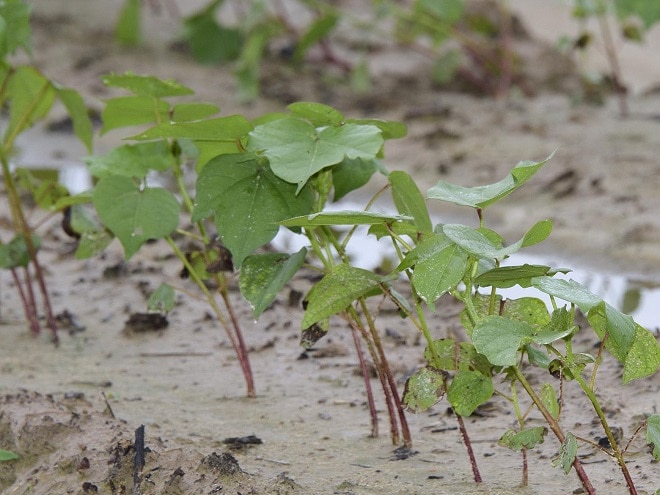Cotton is a major crop in Mississippi. In 2014, it ranked fourth behind poultry, forestry, and soybeans in state commodities, with $403 million dollars of revenue.
Tropical Storm Cindy did not help the state’s cotton crop that struggled with cool and wet weather all spring this year.
Darrin Dodds, cotton specialist with the Mississippi State University Extension Service, said in mid-June, cotton received about a week of the heat and sun it needs to thrive. Weather before that was not ideal, and rain remains in the forecast.
RELATED: Wet weather challenges row crop producers
“Cotton does not deal well with excessive moisture, and we’ve certainly had an abundance of that lately,” Dodds said. “Even before the tropical storm came across the state, we had drainage ditches so full they were backed up onto fields, and growers had to replant many acres because of that.”
The U.S. Department of Agriculture estimated that 45 percent of the crop was in good condition by June 18, and 19 percent looked excellent. Just 36 percent was rated as poor or fair.
“Cotton is very resilient,” Dodds said. “How well cotton yields this year will depend on what the weather does the rest of the growing season. If we have a long fall, cotton can catch up from its slow start.”
At planting, USDA estimated that cotton acres would increase 21 percent from 2016, with more than 12 million acres planted in the U.S. In Mississippi, that increase was greater than 25 percent but less than intended because of spring rains. Mississippi growers harvested 430,000 acres of cotton last year.
“Based on what I heard from growers, I was expecting us to plant about 700,000 acres of cotton, but I suspect we were only able to plant between 550,000 and 600,000 acres,” Dodds said.
Cotton planting started in late April, and growers try to finish by the end of May. Wet fields or lost stands always force some growers to plant in June, but this is not ideal, Dodds said.
Mississippi is riding a five-year streak of record or near-record average yields. The current record is 1,232 pounds per acre, harvested in 2014.
Good cotton prices, especially in relation to prices for other row crops, also helped increase acres planted.
Brian Williams, Extension agricultural economist, said December cotton futures are trading for about 67 cents a pound, while south Delta cash cotton is selling for 67.5 cents a pound.
“Cotton has been on a downward trend for the last two weeks,” Williams said. “For much of the spring, December cotton futures were trading for about 75 cents a pound, but beginning in early June, it began a steady decrease.”
Two things are driving the decline: supply and exports.
“We are expecting a large cotton crop this year, and to this point in the growing season, crop conditions look good. That has fueled the market decline,” Williams said. “Also, exports aren’t as high as many have hoped.”
Information provided by Ms. Bonnie A. Coblentz
MSU Extension Service
Photo by MSU Extension Service/Kevin Hudson




